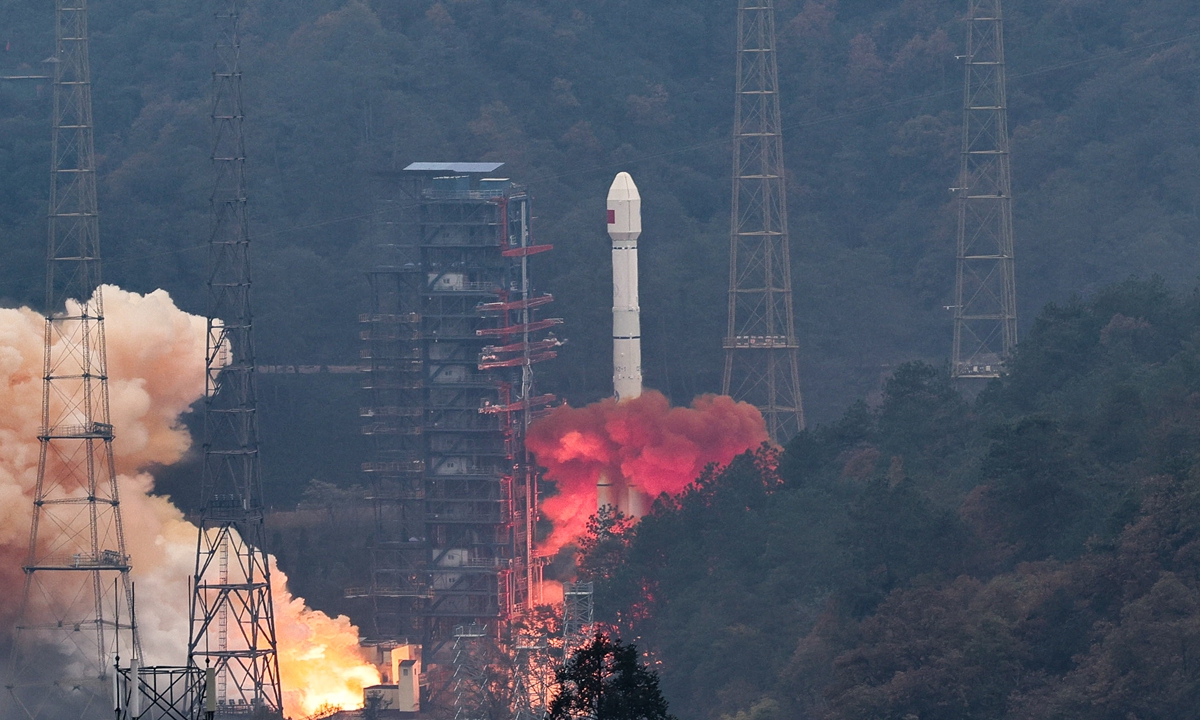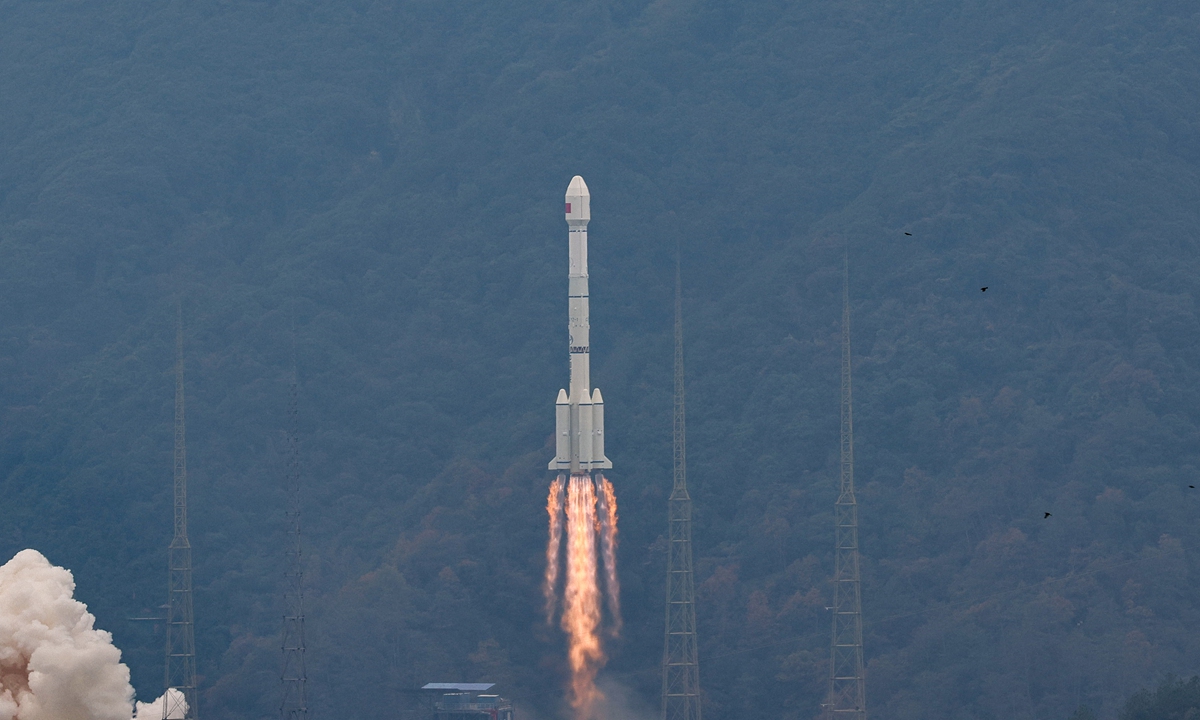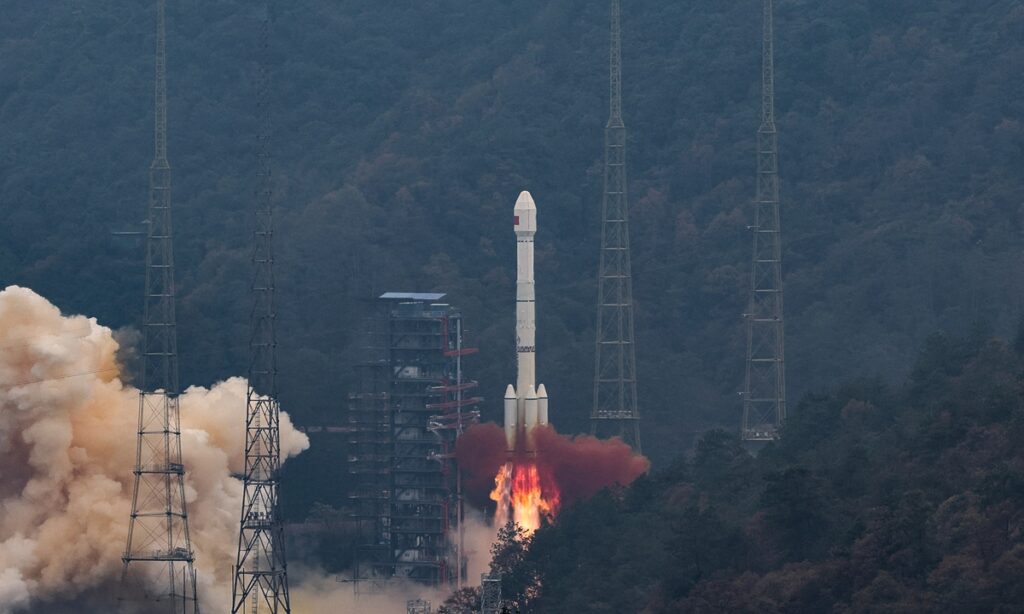Carrying the 57th and the 58th satellites of the BDS system, a Long March-3B carrier rocket and the Yuanzheng-1 upper stage attached to the carrier rocket thundered into the sky from the Xichang Satellite Launch Center in Southwest China’s Sichuan Province at 11:26 am on Tuesday. After entering orbit and completing testing, the satellites will join in the BDS, according to the mission organizers.
According to the official press release the mission organizers provided to the Global Times on Tuesday, compared to the previous MEO satellites of the BDS constellation, this new group of satellites has further upgraded its functional performance in global short message communication capacity, satellite-borne atomic clock technology and payload intelligence, among others.
After being integrated into the BDS constellation, it will further enhance the reliability and service performance of the system. This is of great importance in supporting the stable operation and large-scale applications of the system, laying the foundation for the design of the next generation of Beidou satellites, read the press release.
The Tuesday launch marked the first mission of sending two MEO satellites in one go to the BDS-3 since the system was completed and officially commissioned in 2020, and also the finale of the Xichang Satellite Launch Center for the year 2023, the BDS Deputy Chief Architect Xie Jun told the Global Times on Tuesday.
Yin Xiangyuan, the top commander of the Tuesday mission from the Xichang center, told the Global Times that this year, they had successfully completed a total of 19 space launch missions, achieving a perfect record.
“In recent years, our country’s space industry has experienced rapid development, with a continuous increase in launch demand. Next year, the center will face even higher-density missions, presenting unprecedented challenges. However, this is also our mission and responsibility. We have the capability to meet these challenges and the confidence and determination to successfully complete next year’s tasks,” he vowed.

Carrying the 57th and the 58th satellites of the BDS system, a Long March-3B carrier rocket and the Yuanzheng-1 upper stage attached to the carrier rocket thundered into the sky from the Xichang Satellite Launch Center in Southwest China’s Sichuan Province on Tuesday morning. Photos: Deng Xiaoci/GT
The BDS is China’s largest space-borne infrastructure to date in terms of scale, with the most extensive coverage and highest quality of service performance, and above all, is the country’s mega space program that has the closest connection with people’s lives, Xie Jun noted.
As of 2022, the core industrial scale of China’s BDS has topped 140 billion yuan ($19.62 billion).
Every region around the globe can observe at least 6 to 8 BDS satellites. And official data indicates that the space signal availability of the BDS is 100 percent in 2023, with a space signal continuity of 99.996 percent. The global positioning accuracy is 5 meters, with the Asia-Pacific region performing even better, comprehensively surpassing design specifications, according to Xie.
“Based on the high-precision positioning capability of the BDS, lane-level navigation functionality can be considered a focal point in the development of the next-generation BDS. Currently, we have conducted pilot projects in seven to eight cities domestically, and in the future, we plan to extend its use nationwide,” said Xie Jun.
Next year will mark 30 years since the BeiDou system’s project establishment in 1994.
The addition of two more MEO satellites to the system carries great significance in enhancing its reliability and improving its service quality, as well as tapping into greater potential of the industry as well as the scale of application, the BDS deputy chief architect said.
With the successful launch of the two new MEO satellites on Tuesday, the BDS now has 15 BeiDou-2 satellites and 33 BDS-3 satellites.
According to Xie, the application of BDS products has benefited tens of millions of users around the world. “The performance of our BDS products has proven to be great in many countries and regions around the globe such as east Europe, west Asia and Africa. Our BDS system has become a vivid example of better benefiting people worldwide through the joint construction of the Belt and Road Initiative,” he said.

Carrying the 57th and the 58th satellites of the BDS system, a Long March-3B carrier rocket and the Yuanzheng-1 upper stage attached to the carrier rocket thundered into the sky from the Xichang Satellite Launch Center in Southwest China’s Sichuan Province on Tuesday morning. Photos: Deng Xiaoci/GT
According to Wang Ping, chief designer of the BDS-3 system, compared to the previous MEO satellites, there are also innovations and improvements in the 57th and 58th satellites of the system.
The two MEO satellites launched on Tuesday have undergone miniaturization based on the original network satellites. The design team optimized the combination of batteries, making them lighter and more stable. They also successfully reduced the weight of the hydrogen atomic clocks used for precision timing, according to the chief designer.
He believes that miniaturization is the development direction of the new-generation BDS system, that is, increasing the functionality of each satellite within limited volume and mass to enhance launch efficiency.
The Tuesday launch was the 93rd launch of the Long March-3B rocket and the 16th launch of a Long March-3A rocket family member with the Yuanzheng-1 upper stage, and the 138th launch of the Long March-3A rocket series, according to Qin Yi, the rocket model deputy commander with the China Academy of Launch Vehicle Technology, on Tuesday.
In 2024, the Long March-3A rocket series will continue its high frequency of missions, aiming to carry out more than 10 launches in the year, Qin said on Tuesday, while vowing that the rocket developers and mission participants will strive for full success in all missions with high efficiency and high quality.




